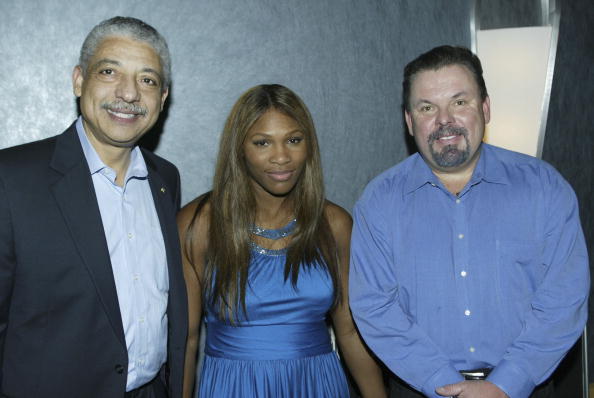What was Thomas Kinkade's Net Worth?
Thomas Kinkade was an American painter who had a net worth of $100 million at the time of his death. Known for his paintings of idyllic pastoral scenes, Thomas Kinkade found enormous success by mass-producing his work through prints and various other licensed products. It has been claimed that 1 in every 20 homes in America contains a Thomas Kinkade painting. Kinkade was criticized during his career for both the kitschy nature of his paintings and various unethical business practices.
Early Life and Education
William Thomas Kinkade III was born on January 19, 1958, in Sacramento, California, and was raised by an impoverished single mother in Placerville. As a teenager, he went to El Dorado High School, graduating in 1976. For his higher education, Kinkade attended the University of California, Berkeley, before transferring to ArtCenter College of Design in Pasadena.
Career Beginnings
Kinkade began his career in the early 1980s when he co-authored the book "The Artist's Guide to Sketching" with his college friend and fellow artist James Gurney. The book was a success, leading both men to secure jobs at the production studio of animator Ralph Bakshi. There, Kinkade created background art for Bakshi's 1983 animated film "Fire and Ice."
Mainstream Success
Kinkade achieved mainstream success as a painter of idyllic pastoral scenes, characteristically including gardens, cottages, streams, and lighthouses. The cottages were typically illuminated from within by a warm glowing light, and were frequently placed in snowy surroundings. Often, Kinkade included Christian iconography in his paintings as well, appealing to socially conservative American values. His key to fame and success was the mass-production of his work through prints and other licensed products, including calendars, greeting cards, and jigsaw puzzles, sold by mail order and in retail stores. Some of his prints feature light effects painted onto the surface of the print by dedicated craftsmen. Between 1997 and 2005, Kinkade reportedly earned around $53 million for his works. He also did a number of large-scale works for major corporations during his career, including ones for anniversaries of Disneyland, Graceland, Yankee Stadium, and the Daytona 500.
Critical Reception
Kinkade's paintings have been heavily criticized for their sentimentality and kitsch factor. Many critics have denounced his works for peddling a nostalgically idealized vision of small-town America. Writer Joan Didion pointed to the insidiousness of Kinkade's paintings when she wrote that they "typically featured a cottage or a house of such insistent coziness as to seem actually sinister, suggestive of a trap designed to attract Hansel and Gretel." At the heart of much of the criticism was Kinkade's process of mass-production and the extent to which he commercialized his art. Writer Nathan Rabin wrote that "perhaps no other painter has been as shameless or as successful at transforming himself into a corporation."

Thomas Kinkade (far right) with Serena Williams Michael Buckner/Getty Images
Charity
Kinkade was substantially involved in charity, especially pertaining to children and the arts. He donated to such nonprofits as the Make-A-Wish Foundation, Art for Children, and the Salvation Army, and served as a national spokesman for Make-A-Wish. In 2005, Kinkade became the second ambassador of the nonprofit Points of Light, which was founded by George H. W. Bush to promote volunteerism.
Controversies Over Conduct
Kinkade created significant controversy for his business and personal conduct. His company was accused of unfair dealings with owners of his franchise galleries, and in one case was ordered to pay damages and fees to a jilted party for failing to disclose information that would have discouraged that party from investing in the gallery. Additionally, some gallery owners accused Kinkade's company of pressuring them to open new galleries that were not financially viable, as well as to accept expensive inventory that wasn't salable. On the personal level, Kinkade was frequently accused of heckling other artists, and of regularly urinating in public. Some of his bad behavior allegedly stemmed from his alcoholism. In 2010, he was arrested and convicted for DUI in Carmel-by-the-Sea, California.
Personal Life and Death
In 1982, Kinkade married Nanette Willey. They had four daughters, all of whom became successful artists. The couple separated around 2010, and Kinkade subsequently dated Amy Pinto-Walsh.
On April 6, 2012, Kinkade passed away at his home in Monte Sereno, California. An autopsy revealed that he had died from acute intoxication from alcohol and the drug diazepam. A documentary about Kinkade, "Art for Everybody," came out in 2023.
/2010/12/Thomas-Kinkade.png)
/2022/03/jackson-pollack.jpg)
/2018/11/red2.jpg)
/2014/07/Andy-Warhol-1.jpg)
/2021/11/basquiat.jpg)
/2018/12/nr.jpg)
/2022/10/Felix-Baumgartner.png)
/2015/09/GettyImages-483593016.jpg)
/2020/06/john-oliver.jpg)
/2019/01/GettyImages-490454810.jpg)
/2020/10/Dana-Carvey-1.jpg)
/2018/06/Mike-Lindell.jpg)
/2020/02/paul-anka.jpg)
/2009/11/Steve-Carell-1.jpg)
/2021/07/jerry-west.jpg)
/2009/09/Jon-Stewart.jpg)
/2009/11/Seth-Meyers.jpg)
/2010/12/Thomas-Kinkade.png)
/2022/03/jackson-pollack.jpg)
/2012/12/GettyImages-522358450.jpg)
/2025/02/missing_profile.jpg)
/2018/11/red2.jpg)
/2020/09/kathy-hilton.jpg)
/2011/02/GettyImages-95692991.jpg)